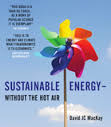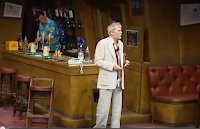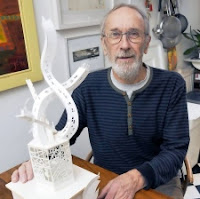Alf Dubs, himself one of the 699 children brought out of Prague by the individual action of the stockbroker and humanitarian, Nicholas Winton, prior to the Nazi invasion of Czechoslovakia in 1939.
Alf had said in the House of Lords debate : "It is thanks to Sir Nicky Winton, who helped to organise Kindertransports from Czechoslovakia, that I got here at all. I almost certainly owe my life to him." This was the main motivation behind his amendment to the Bill.
 The year before, when Alf was 5 years old, representative from 32 western states had gathered in the pretty resort town of Evian in Southern France. They were there to discuss whether to admit a
The year before, when Alf was 5 years old, representative from 32 western states had gathered in the pretty resort town of Evian in Southern France. They were there to discuss whether to admit a growing number of Jewish refugees, fleeing from persecution in Nazi Germany and Austria. After several days of negotiations, most countries including Britain, represented by Lord Winterton, decided to do nothing.
 Alfred was born in the republic of Czechoslovakia in 1933, the only child of a Czech mother and Jewish father and in a family prosperous enough to take summer holidays in Hungary. Hitler's coming to power in Germany in the year of his birth and his ambition to expand the Third Reich into neighbouring countries immediately cast a shadow over his childhood and he remembers "when the Germans occupied Prague we had to tear out the picture of President Beneš out of the school book and stick in a picture of Hitler."
Alfred was born in the republic of Czechoslovakia in 1933, the only child of a Czech mother and Jewish father and in a family prosperous enough to take summer holidays in Hungary. Hitler's coming to power in Germany in the year of his birth and his ambition to expand the Third Reich into neighbouring countries immediately cast a shadow over his childhood and he remembers "when the Germans occupied Prague we had to tear out the picture of President Beneš out of the school book and stick in a picture of Hitler." The German annexation of young Alfred's country meant that "my father left Prague the day the Germans invaded, which I think was March or April 1939. He just disappeared. His cousins, with who discussed it, apparently, they said they were staying. He said he was getting out. They ended up in Auschwitz. I never discussed why he knew what he knew or why he did what he did, because most of the Jews in Central Europe just waited for things to happen and they died. They ended up in the camps."
The German annexation of young Alfred's country meant that "my father left Prague the day the Germans invaded, which I think was March or April 1939. He just disappeared. His cousins, with who discussed it, apparently, they said they were staying. He said he was getting out. They ended up in Auschwitz. I never discussed why he knew what he knew or why he did what he did, because most of the Jews in Central Europe just waited for things to happen and they died. They ended up in the camps."So at the age of six he was without a father : "My mother said "he's gone away" and I was always told never to mention anything at school which was talked about at home. I didn't quite know what was happening. I knew there was tension. I knew my father had disappeared suddenly. There were German soldiers everywhere in Prague, but I wasn't particularly knowledgeable or sophisticated to know really what it meant, except I knew it meant something because there were tensions, that my mother was very worried about everything, I could tell, and then she said I was "going to join my father" because I kept asking her what had happened to him."
Alf's memory of events was sharp which he put down to the fact that : "When I was seven I started thinking about what happened to me when I was five or six and that fixed it in my memory in a way it would not have done had I no change in my life from year one to eighteen."
He remembered his mother : "She put me on the train. I can still see in front of me Prague Station (Praha Hlavni Nadrazi) and my mother standing there and looking anxious. It was about midnight. A German soldier with a swastika standing there." He reflected : "I was very lucky because most of the Kindertransport children said "Goodbye" to their parents in Prague and never saw them again"
"The parting for my mother was very traumatic because of the tensions. We got to the Czech-German border and the documents weren't right so they had to send somebody by car to get the documents. We went across Germany. A German soldier came in once and actually he was quite friendly which
 surprised us and when we got to Holland I looked out for windmills and wooden shoes and saw no windmills" and "We got to the Dutch border and the older ones, I was one of the youngest on this train, the older ones, they cheered, because they knew it was significant to have got out of Germany, because the train ran across Germany. There we got a boat to Harwich and then we got off at Liverpool Street Station where there's now a memorial to the Kindertransport. We had numbers, labels and things and most of them were taken by foster parents. I was lucky. I had a father who took me. I went to my father and then he was anxious if my mother would get out." Alf reflected that : "My mother gave me a little rucksack of food and I didn't eat anything for 2 days, so I must have been traumatised."
surprised us and when we got to Holland I looked out for windmills and wooden shoes and saw no windmills" and "We got to the Dutch border and the older ones, I was one of the youngest on this train, the older ones, they cheered, because they knew it was significant to have got out of Germany, because the train ran across Germany. There we got a boat to Harwich and then we got off at Liverpool Street Station where there's now a memorial to the Kindertransport. We had numbers, labels and things and most of them were taken by foster parents. I was lucky. I had a father who took me. I went to my father and then he was anxious if my mother would get out." Alf reflected that : "My mother gave me a little rucksack of food and I didn't eat anything for 2 days, so I must have been traumatised."http://news.bbc.co.uk/1/hi/uk/8227657.stm
 Then : "My father had been offered a job in Northern Ireland and so we went to Northern Ireland. It's quite funny because my father had written to my mother and said if you manage to get out of Prague we're going to Cookstown. My mother looked up an atlas confusing Cookstown in Northern Ireland with Cooktown in Australia." At first his mother was refused permission to leave Prague, a cause of great anxiety, but eventually got an exit visa and joined them in Britain.
Then : "My father had been offered a job in Northern Ireland and so we went to Northern Ireland. It's quite funny because my father had written to my mother and said if you manage to get out of Prague we're going to Cookstown. My mother looked up an atlas confusing Cookstown in Northern Ireland with Cooktown in Australia." At first his mother was refused permission to leave Prague, a cause of great anxiety, but eventually got an exit visa and joined them in Britain. "So we went immediately to Northern Ireland and a few months later my father had a heart attack and died. So we came back to England from Northern Ireland" For him, in addition, to his grief : “When your father dies when you’re 7… For the rest of my life I had hundreds of questions to ask him, which of course I could never ask him" and for his mother : "It was quite tough for her : no husband, no money, no family." Eventually : "she arranged for me to go the Czechoslovak School which was actually in Wales. So I went there for two and a half years." "There were 400 of us in this school. So we did speak Czech then."
For secondary education he gained a place at Cheadle Hulme School an independent day school in Stockport and where : "When I was about 12 or 13, or even perhaps, younger I began wondering : 'why what had happened to me and the world ?' and I said to myself : "if evil politicians can do so many terrible things maybe politics could also be a way of changing that." In other words if politics has the power to make things worse for people, it could also have the power to make things better for people." So I got passionately interested in politics."
 "After I left school I went to the London School of Economics because that was the most political university in Britain and I studied Economics and Politics. I joined the Labour Party. I became a local councillor and the I stood for Parliament and the first time I didn't and then I got elected to parliament and then I lost in one election and then I was head of the Refugee Council. It was quite odd, somebody who was a refugee to actually become the Head of the Refugee Council, although the refugees at that point, this was later, were mostly from other countries, not European and then I was put in the House of Lords, where I still am."
"After I left school I went to the London School of Economics because that was the most political university in Britain and I studied Economics and Politics. I joined the Labour Party. I became a local councillor and the I stood for Parliament and the first time I didn't and then I got elected to parliament and then I lost in one election and then I was head of the Refugee Council. It was quite odd, somebody who was a refugee to actually become the Head of the Refugee Council, although the refugees at that point, this was later, were mostly from other countries, not European and then I was put in the House of Lords, where I still am.""One election I stood in the centre of London. I didn't win and I was a part-Jewish refugee from Prague and my opponent was a man called Christopher Tugenhadt who stood for the Conservatives who was a Jewish refugee fro Vienna and the newspapers didn't pick up that the battle for the constituency for the middle of London was being contested by two people from Central Europe."
"I didn't know for years about Nicholas Winton. I knew I'd come on a Kindertransport and then only 15-20 years ago the news got out and I met him several times." The occasion had been when Nicholas made an appearance on Esther Rantzen's BBC tv programme, 'That's Life', in 1988 and asked "whether any in the audience owed their lives to him ? and, if so, to stand", at which point more than two dozen people surrounding him rose and applauded and because the programme was aired nationwide, many other rescued children wrote to and thanked him : https://www.youtube.com/watch?v=6_nFuJAF5F0

Before Nicholas died last year Alf said : "We all feel we're 'The Winton Children' and we have an obvious affection for him because I would have thought none of us would have survived had it not been for him, that he got us out. So one feels pretty warm towards somebody who saved ones life."
For the time being, the Government's refusal to allow Alf's 3,000 child refugees to enter Britain has scuppered his chances of following in the footsteps of his hero, Nicholas. It also reveals Government policy towards refugees to be little different to what it had been in 1938. The door is closed.
Please sign this petition : At 100,000 signatures, this petition will be considered for debate in Parliament :
Alf's e-petition : https://petition.parliament.uk/petitions/128833
The Government should accept the call to give sanctuary to child refugees who are alone and at risk in Europe.
We will champion freedom of
represent the iall the people who live in their constituences.
342 votes to 254. All those who voted against were Conservatives.
The legislation is expected to gain royal assent within days after peers agreed to end the parliamentary “ping-pong” phase where it moves between the two houses until agreement is reached.
While the passage of the withdrawal agreement bill (Wab), which puts the deal into legislation, became a formality after Johnson won a significant majority in December’s election, it is nonetheless a symbolically significant moment after Theresa May’s plan was rejected by MPs three times.
Advertisement
In a brief comment calling for an end to “rancour and division”, Johnson said: “At times it felt like we would never cross the Brexit finish line, but we’ve done it.”
There was, however, some final controversy, as opposition MPs condemned the government for ordering Conservative MPs to oppose an amendment drafted by Alf Dubs, the Labour peer and former child refugee, guaranteeing family reunion rights. Lord Dubs called the move “bitterly disappointing”.
The amendment, passed in the Lords on Tuesday, was rejected in the Commons by 342 votes to 254. All those who voted against were Conservatives.
Sign up to our Brexit weekly briefing
Read more
“What could be more humane than asking that unaccompanied child refugees stranded in Europe be able to join relatives in this country?” Dubs said in a tweet.
It was among five amendments to the EU withdrawal agreement bill passed by peers which have now been overturned. The bill puts the government’s Brexit deal into law.
There were also amendments on EU workers legally residing in the UK getting physical proof of their right to remain; a commitment to the UK parliament not legislating for devolved matters without the consent of the devolved legislature affected; and two relating to the power of courts to depart from European court of justice rulings.
Labour’s Diane Abbott, the shadow home secretary, said the government was “attempting to shirk its moral and legal obligation to child refugees and their families”.
She said: “The Tory manifesto just a month ago claimed they would continue to support refugees, and even that they would increase that support. This is a shameful betrayal of those promises.”
It is difficult not to agree withStuart McDonald, the SNP’s immigration spokesperson, who said: “Rather than stepping up and playing its role in addressing the refugee crisis, the toxic Tory government has instead lurched to the extremes and closed the door on some of the most vulnerable children in the world.”
Dubs, who came to the UK as a Kindertransport child refugee after fleeing Prague in 1939, has urged the government to enshrine, after Brexit, the principle of family reunion for child refugees fleeing conflict .
Responding later in the Lords, Dubs said he noted government promises to make a statement on the issue in the next couple of months, saying ministers should explain how they would make sure the system was ready for the start of 2021, when the Brexit transition period ends.
While the measure was originally in the bill, it was removed after December’s election victory for Boris Johnson, with the government insisting it would stick to the commitment but did not see the need to put it into a Brexit bill.
“The government’s policy is unchanged. Delivering on it will not require legislation,” the Brexit secretary, Stephen Barclay, told MPs as he explained to the Commons why ministers opposed the amendment.
“Primary legislation cannot deliver the best outcomes for these children as it cannot guarantee that we will reach an agreement. And that is why this is ultimately a matter which must be negotiated with the EU, and the government is committed to seeking the best possible outcome in these negotiations.”
Barclay came under pressure from MPs to explain his reasoning. Yvette Cooper, the Labour former chair of the home affairs committee, said she did not understand the active decision to remove the measure from the bill.
“There’s loads of things in legislation through the decades that the government says it agrees with and so it says it’s not needed, but it doesn’t remove it from the statute book,” she said. “And that is what makes us all suspicious.”
Barclay replied: “The reason is the purpose of this legislation is to implement in domestic law the international agreement we’ve reached.”
Topics



















































